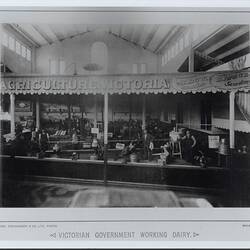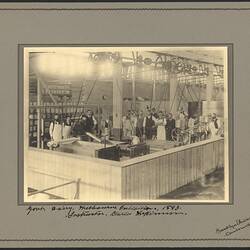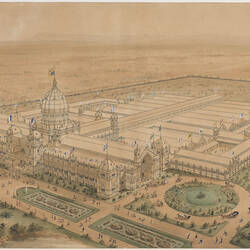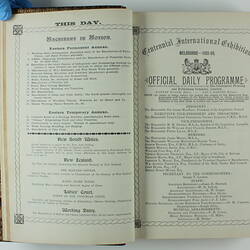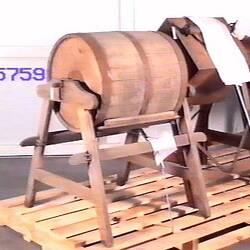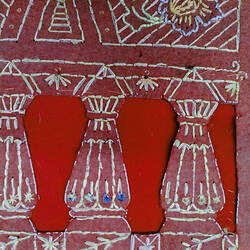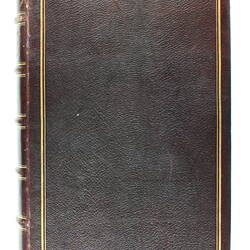Summary
The model working dairy, part of 'Machinery in Motion' at the Melbourne Centennial International Exhibition (MCIE) received the closest attention from visitors and was said to have been the most successful part of the MCIE. Located in the Eastern Permanent Annexe, visitors were able to view cream separators and churns in action, extracting cream from many gallons milk each hour. Visitors could also purchase butter manufactured on site from the most innovative machines of the 19th Century.
Eastern Machinery Annexe
The 1888 Melbourne Centennial International Exhibition (MCIE), celebrating a century of Australian settlement, was held at the (Royal) Exhibition Building, Melbourne, with nearly 40 countries sending their exhibits and approximately 2 million visits over a six month period. The Eastern permanent machinery annexe displayed an array of machinery with a large amount of space taken up by iron work, implements and mechanical appliances, so varied that many visitors were said to get lost into the "labyrinth of ideas of human ingenuity" (The Age 1888, p. 2). Machinery in motion was much more attractive than being still and although this part only formed a small portion of the exhibition, it continuously received the closest attention from visitors and was undoubtedly the most successful part of the MCIE. (The Leader 1888, p. 19).
The Model Working Dairy
Said to have been the most unique and interesting exhibit was the model working dairy, exhibited by the Victorian Department of Agriculture in the Eastern Permanent Machinery Annexe (The Sydney Morning Herald 1888, p. 3). Displayed were several new pieces of machinery that were shown in motion where crowds congregated to view all the best kinds of separators in operation (The Sydney Morning Herald 1888, p. 3). The exhibit was implemented to illustrate the superiority of the most modern appliances for butter and cheese making (The Express and Telegraph 1888, p. 3).
Although granted a limited amount of space, the model working dairy, its cream separators and churns were well arranged (The Leader 1888, p. 11). On display were four cream separators, which were situated near the main entrance on the Nicholson-street side, being the easiest to find (The Express and Telegraph 1888, p. 3). Three of the four separators could extract cream from 90 gallons of milk per hour while the other separator named the Turbine, was of 120 gallons per hour capacity (The Leader 1888, p. 11). The Turbine was the latest innovation at the time and was simpler in design as it could be worked by horse power or by the use of a boiler without an engine (The Leader 1888, p. 11). Another improvement that was demonstrated consisted of the use of steam to work a force pump for the purpose of sending the milk from which the cream had been extracted to any given place (The Leader 1888, p. 11). As well as the larger separators, there were several baby separators exhibited that were equal to 12 gallons per hour each, which suited the requirements of all dairy men, whether they kept 5 or 500 cows (The Leader 1888, p. 11).
Of interest to visitors and part of the working dairy plant was a model of a cool chamber suitable for a factory storing butter or cheese, or for supplying cool air (The Age 1888, p. 2). This cool chamber was built from wood with double walls and the spaces in between filled with sawdust (The Age 1888, p. 2). Additionally, a number of the best style butter boxes for sending butter in prints to the market were also on display (The Age 1888, p. 2). Composed of a series of wooden trays, the boxes were made of kauri pine and were able to carry 140 half pound prints while leather straps were placed on the top of each box so that they were easier to lift (The Age 1888, p. 2). Although a small matter, it was a very useful invention at the time (The Age 1888, p. 2).
Also of high demand from visitors was the purchase of butter that was manufactured from a butter worker, where demand was far in excess of the supply (The Express and Telegraph 1888, p. 3). While there was much anticipation in regards to viewing thousands of gallons of milk being processed per day, excitement also revolved around lectures that were being offered to anyone who desired lessons on the processes of cream separating, butter and cheese making (The Leader 1888, p. 11). Overall, the working dairy exhibit was most fascinating as every visitor was afforded the opportunity of not only studying the scientific methods of dairy farming, but they were able to see the latest and most improved machines in action (The Advocate 1888, p, 7).
References
'Machinery at the Centennial Exhibition' 1888, The Leader, 1 September, p. 19.
'The Machinery Exhibits' 1888, The Age, 28 August, p. 2.
'The Model Dairy' 1888, The Advocate, 1 December, p. 6.
'The Working Dairy' 1888, The Express and Telegraph, 13 August, p. 3.
'The Working Dairy' 1888, The Leader, 18 August, p. 11.
'The Working Dairy' 1888, The Sydney Morning Herald, 26 January, p. 3.
More Information
-
Keywords
-
Authors
-
Article types

